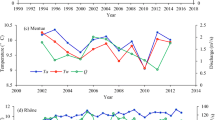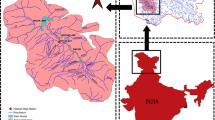Abstract
CHLFuzzy is a user-friendly, flexible, multiple-input single-output Takagi-Sugeno fuzzy rule based model developed in a MS-Excel® spreadsheet environment. The model receives a raw dataset consisting of four predictor variables, e.g., water temperature, dissolved oxygen content, dissolved inorganic nitrogen concentration, and solar radiation levels. It then defines fuzzy sets according to a collection of fuzzy membership functions, allowing for the establishment of fuzzy ‘if–then’ rules, and predicts chlorophyll-a concentrations, which highly compare to the measured ones. The performance of the model was tested against the Adaptive Neural Fuzzy Inference System (ANFIS), showing satisfactory results. An extensive dataset of environmental observations in Vassova Lagoon (Northern Greece), during the years 2001–2002, was used to train the model and an independent dataset collected during 2004 was used to validate CHLFuzzy and ANFIS models. Although both models showed a similar performance on the training dataset, with quite satisfactory agreement between observed and modeled chlorophyll-a values, the best results were obtained using the CHLfuzzy model. Similarly, the CHLfuzzy model depicted a fairly good ability to hindcast chlorophyll-a concentrations for the verification dataset, thus improving ANFIS model forecasts. Overall results suggest that CHLfuzzy can potentially be used as a lagoon water quality forecasting tool requiring limited computational cost.









Similar content being viewed by others
References
Adriaenssens, V., B. de Baets, P. Goethals & N. de Pauw, 2004. Fuzzy rule-based models for decision support in ecosystem management. The Science of the Total Environment 319: 1–12.
Beck, M. B., 2005. Environmental foresight and structural change. Environmental Modelling & Software 20: 651–670.
Bobbin, J. & F. Recknagel, 2001. Knowledge discovery for prediction and explanation of blue-green algal dynamics in lakes by evolutionary algorithms. Ecological Modelling 146: 253–262.
Cao, H., F. Recknagel, G.-J. Joo, D.-K. Kim, 2006. Discovery of predictive rule sets for chlorophyll-a dynamics in the Nakdong River (Korea) by means of the hybrid evolutionary algorithm HEA. Ecological Informatics 1: 43–53.
Chang, N. B., H. W. Chen & S. K. Ning, 2001. Identification of river water quality using the Fuzzy synthetic evaluation approach. Journal of Environmental Management 63: 293–305.
Chau, K., 2006. A review on integration of artificial intelligence into water quality modeling. Marine Pollution Bulletin 52:726–733.
Chen, D. G., N. B. Hargreaves, D. M. Ware & Y. Liu, 2000. A fuzzy logic model with genetic algorithm for analyzing fish stock-recruitment relationships. Canadian Journal of Fishery and Aquatic Science 57: 1878–1887.
Chen, Q. & A. E. Mynett, 2003. Integration of data mining techniques and heuristic knowledge in fuzzy logic modelling of eutrophication in Taihu Lake. Ecological Modelling 162: 55–67.
Chen, Q. & A. E. Mynett, 2006. Modelling algal blooms in the Dutch coastal waters by integrated numerical and fuzzy cellular automata approaches. Ecological Modelling 199: 73–81.
Cornelissen A. M. G., van den Berg J., Koops W. J., Grossman M., Udo H. M. J. (2001) Assessment of the contribution of sustainability indicators to sustainable development: a novel approach using fuzzy set theory. Agricultural Ecosystems Environment 86: 173–185
Dombi, J., 1990. Membership function as an evaluation. Fuzzy Sets and Systems 35: 1–21.
Fdez-Riverola, F. & J. M. Corchado, 2004. FSfRT : Forecasting system for Red Tides. Applied Intelligence 21: 254–264.
Giusti, E. & S. Marsili-Libelli, 2005. Modelling the interactions between nutrients and the submerged vegetation in the Orbetello Lagoon. Ecological Modelling 184: 141–161.
Haan, C. T., 1977. Statistical Methods in Hydrology. The Iowa State University Press.
Hartnett, M. & S. Nash, 2004. Modelling nutrient and chlorophyll-a dynamics in an Irish brackish water body. Environmental Modelling & Software 19: 47–56.
Hession, W. C., V. O. Shanholtz, S. Mostaghimi, T. A. Dillaha, 1994. Uncalibrated performance of the finite element storm hydrograph model. Transactions of ASAE 37: 777–783.
Jang, J. S. R., 1993. ANFIS: adaptive network-based fuzzy inference system. IEEE Transactions on Systems, Man and Cybernetics 23: 665–685.
Jeong, K. S., G. L. Joo, H. W. Kim, K. Ha & F. Recknagel, 2001. Prediction and elucidation of phytoplankton dynamics in the Nakdong River (Korea) by means of a recurrent artificial neural network. Ecological Modelling 146: 115–129.
Jørgensen, S. E., 1994. Fundamentals of Ecological Modelling, 2nd ed. Elsevier, Amsterdam.
Kornecki, T. S., G. J. Sabbagh & D. E. Storm, 1999. Evaluation of runoff, erosion and phosphorus modelling system-SIMPLE. Journal of the American Water Resources Association 35: 807–820.
Kung, H., L. Ying & Y. C. Liu, 1992. A complementary tool to water quality index: fuzzy clustering analysis. Water Resources Bulletin 28: 525–533.
Laanemets, J., M. -J. Lilover, U. Raudsepp, R. Autio, E. Vahtera, I. Lips & U. Lips, 2006. A fuzzy logic model to describe the cyanobacteria Nodularia spumigena blooms in the Gulf of Finland, Baltic Sea. In Kuparinen, J., E. Sandberg-Kilpi & J. Matttila (eds), Baltic Sea: A Lost System or a Future Treasury, Hydrobiologia 554: 31–45.
Lonin, S. E. & Y. S. Tuchkovenko, 2001. Water quality modelling for the ecosystem of the Cienaga de Tesca coastal lagoon. Ecological Modelling 144: 279–293.
Lu, R. -S. & S. -L. Lo, 2002. Diagnosing reservoir water quality using self-organizing maps and fuzzy theory. Water Research 36: 2265–2274.
Maier, H. R., T. Sayed & B. J. Lence, 2001. Forecasting cyanobacterium Anabaena spp. in the River Murray, South Australia, using B-spline neurofuzzy models. Ecological Modelling 146: 85–96.
Marsili-Libelli, S., 2004. Fuzzy prediction of the algal blooms in the Orbetello lagoon. Environmental Modelling & Software 19: 799–808.
Metternicht, G., 2001. Assessing temporal and spatial changes of salinity using fuzzy logic, remote sensing and GIS. Foundations of an expert system. Ecological Modelling 144: 163–179.
Newton, A. & S. M. Mudge, 2005. Lagoon-sea exchanges, nutrient dynamics and water quality management of the Ria Formosa (Portugal). Estuarine, Coastal & Shelf Science 62: 405–414.
Recknagel, F., J. Bobbin, P. Whigham & H. Wilson, 2002. Comparative application of artificial neural networks and genetic algorithms for multivariate time-series modeling of algal blooms in freshwater lakes. Journal of Hydroinformatics 4: 125–134.
Scardi, M., 2001. Advances in neural network modelling of phytoplankton primary production. Ecological Modelling 146: 33–45.
Silvert, W., 2000. Fuzzy indices of environmental conditions. Ecological Modelling 130: 111–119.
Soyupak, S. & D. -G. Chen, 2004. Fuzzy logic model to estimate seasonal pseudo steady state chlorophyll-a concentrations in reservoirs. Environmental Modelling and Assessment 9: 51–59.
Su, F., C. Zhou, V. Lyne, Y. Du & W. Shi, 2004. A data-mining approach to determine the spatio-temporal relationship between environmental factors and fish distribution. Ecological Modelling 174: 421–431.
Sylaios, G., V. A. Tsihrintzis, C. Akratos & K. Haralambidou, 2004. Monitoring and analysis of water, salt and nutrient fluxes at the mouth of a lagoon. Water, Air and Soil Pollution: Focus 4: 111–125.
Sylaios, G., V. A. Tsihrintzis, C. Akratos & K. Haralambidou, 2006. Quantification of water, salt and nutrient exchange processes at the mouth of a Mediterranean coastal lagoon. Environmental Monitoring & Assessment 119: 275–301.
Tsihrintzis V. A., John D. L., Tremblay P. J. (1998) Hydrodynamic Modeling of Wetlands for flood Detention. Water Resources Management 12: 251–269
Tsihrintzis, V. A., G. K. Sylaios, M. Sidiropoulou & E. Koutrakis, 2007. Hydrodynamic modeling and management alternatives in a Mediterranean, fishery exploited coastal lagoon. Aquacultural Engineering 36: 310–324.
Wei, B., N. Sugiura & T. Maekawa, 2001. Use of artificial neural network in the prediction of algal blooms. Water Research 35: 2022–2028.
Yabunaka, K., M. Hosomi & A. Murakami, 1997. Novel application of a back-propagation artificial neural network model formulated to predict algal blooms. Water Science Technology 36: 89–97.
Author information
Authors and Affiliations
Corresponding author
Additional information
Handling editor: P. Viaroli
Rights and permissions
About this article
Cite this article
Sylaios, G.K., Gitsakis, N., Koutroumanidis, T. et al. CHLfuzzy: a spreadsheet tool for the fuzzy modeling of chlorophyll concentrations in coastal lagoons. Hydrobiologia 610, 99–112 (2008). https://doi.org/10.1007/s10750-008-9358-4
Received:
Revised:
Accepted:
Published:
Issue Date:
DOI: https://doi.org/10.1007/s10750-008-9358-4




